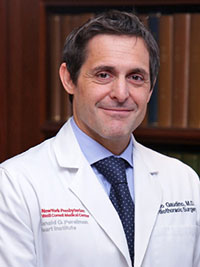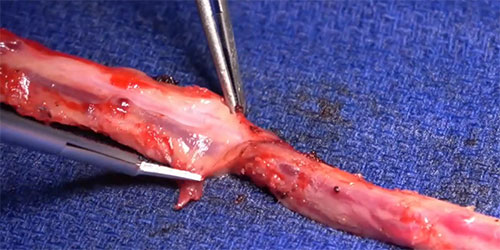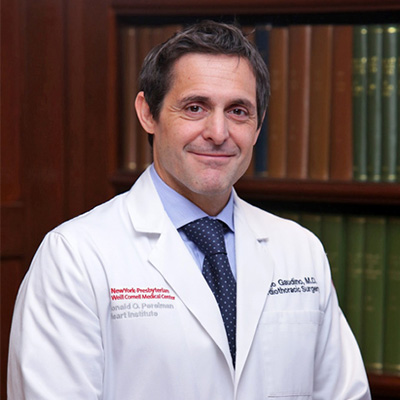Dr. Mario Gaudino
According to the American Heart Association, coronary artery bypass grafting (CABG) is the most frequently performed cardiac surgery, with about 370,000 cases annually in the United States alone and in excess of 800,000 worldwide. Traditionally, CABG has been performed using the left internal thoracic artery to graft the left anterior descending artery, with the saphenous vein harvested from the leg to bypass the other coronary arteries.
“This approach has been the standard for many years, and it is still the standard in the United States and to a lesser extent in Europe,” says Mario F.L. Gaudino, MD, a cardiothoracic surgeon at NewYork-Presbyterian/Weill Cornell Medical Center and the Stephen and Suzanne Weiss Professor in Cardiothoracic Surgery at Weill Cornell Medicine. “In the United States, approximately 90 percent of the operations are still performed in this way.”
The Evolution of Multiple Arterial Grafting
It was some 20 years ago that cardiac surgeons began exploring the possibility that using more than one artery rather than a vein could be better for the patient. “Compared to the vein, the idea was, and it has been successfully proven, that an artery will last longer, stay open longer, and is able to function for a longer period of time in coronary circulation,” says Dr. Gaudino. “Biologically these two conduits are designed to do different things and to work in different environments. And the environment of an artery is much more similar to the heart than that of the saphenous vein.”
The introduction of multiple arterial grafts for CABG was occurring as Dr. Gaudino was starting his career in cardiac surgery as a resident at the University of Rome, Faculty of Medicine and Surgery. “It was the peak of enthusiasm for the use of arterial conduits with CABG,” says Dr. Gaudino. “At the university, we were particularly focused on the radial artery and were among the very first groups in Europe to use it in this way.”
Dr. Gaudino remained at the University of Rome as a member of the faculty. He and his colleagues continued at the forefront of research on the radial artery, and again were among the first to present data on patient follow-up at one year, five years, and 10 years. “Basically all my training and then my younger attending years were spent taking care of patients undergoing CABG so my early career really developed in parallel with the evolution of the radial artery,” notes Dr. Gaudino. In 2014, Dr. Gaudino joined the Department of Cardiothoracic Surgery at NewYork-Presbyterian/Weill Cornell, where he completed a fellowship in Advanced Cardiovascular/Aortic Aneurysm Surgery and was then recruited to join the faculty.
Dr. Gaudino continues as an influential researcher in cardiac surgery, with a major concentration on CABG and the use of the radial artery. Indeed, he has authored more than 600 peer-reviewed journal articles and numerous book chapters in the field along the way. Despite growing evidence on the benefit of multi-arterial grafts, adoption of their use by cardiac surgeons failed to take hold, with less than 10 percent of patients who currently undergo elective CABG receiving more than one arterial graft; the radial artery graft is used in less than 7 percent of these surgeries.
Preparation of the radial artery graft for coronary artery bypass surgery
“The first two decades of my career, in addition to operating on patients, were dedicated to studying the radial artery, and we were able to demonstrate it had a better patency rate than the saphenous vein,” says Dr. Gaudino. “It has been a longer journey than expected. When we started, nobody knew what the radial artery was and many colleagues were skeptical or concerned about taking this artery out of the arm and putting it into the heart. It was the right idea at the beginning, and to our credit, we never gave up. We kept following these patients and accumulating data. In the last five years, we were finally able to show, convincingly, that the outcomes of patients are better when the radial artery is used rather than the saphenous vein.”
A Turning Point for the Radial Artery Conversation
Seminal research by Dr. Gaudino and his co-investigators from five countries in the Radial Artery Database International Alliance (RADIAL) project turned the corner on acceptance of the radial artery as the second arterial conduit, with initial results published in the May 31, 2018, issue of The New England Journal of Medicine, and longer-term follow-up published in the July 14, 2020, issue of JAMA. The research involved a patient-level combined analysis of randomized, controlled trials to compare radial artery grafts to saphenous vein grafts for CABG to address the shortcomings of previous trials that were individually underpowered to detect differences in the frequency of clinical events.
Specifically, the researchers identified 1,036 patients – 534 had radial artery grafts and 502 had saphenous vein grafts – from six clinical trials and analyzed primary outcomes related to major adverse cardiac events, including the composite of death, myocardial infarction, or repeat revascularization, and a secondary outcome of graft patency on follow-up angiography. By pooling the data from those trials for comparison of the two grafts, the investigators demonstrated that radial artery grafts for CABG resulted in a significantly lower risk of adverse cardiac events and a higher rate of patency at five years of follow-up.
Related studies and sub-studies on the radial artery led by Dr. Gaudino continue to generate attention, with ongoing publications in peer-reviewed journals such as the Journal of Thoracic and Cardiovascular Surgery, Journal of the American College of Cardiology, and the European Heart Journal, to name a few.
Current Phase of Study: The ROMA Trial
The scientific journey led by Dr. Gaudino continues in earnest. With support from the National Heart, Lung, and Blood Institute and the Canadian Institutes of Health Research, Weill Cornell Medicine is the sponsor of the largest randomized trial evaluating the clinical effect of doing the standard operation or the operation using multiple arteries. The ROMA (Randomization of Single vs. Multiple Arterial Grafts) Trial, which opened in January 2018, is an event-driven, international multicenter clinical trial to test the hypothesis that “in patients undergoing primary isolated non-emergent CABG, the use of two or more arterial grafts compared to a single arterial graft is associated with a reduction in the composite outcome of death from any cause, any stroke, post discharge myocardial infarction and/or repeat revascularization.”
Dr. Gaudino, along with Stephen Fremes, MD, at Sunnybrook Health Sciences Centre in Toronto, Ontario, serve as the Principal Investigators of the ROMA Trial, which also seeks to determine if the use of two or more arterial grafts compared to a single arterial graft is associated with improved survival. Patients in the multiple arterial graft experimental arm receive at least two arterial grafts – the left internal thoracic artery with the addition of either the right internal thoracic artery or the radial artery as the second conduit. As of April 2022, more than 3,800 subjects have been enrolled across 70 sites toward an estimated enrollment of 4,300 patients.
With strong data now available and the endorsement for use of the radial artery graft by both the European and American professional societies, we are beginning to see a transition toward the use of multi-arterial CABG with radial artery graft as the second conduit.
— Dr. Mario Gaudino
In 2018, with the validity of the radial artery as a second conduit firmly established – largely due to studies conducted by Dr. Gaudino and his colleagues – the use of the radial artery received a class one recommendation in the European Society of Cardiology (ESC) and European Association for Cardio-Thoracic Surgery (EACTS) Guidelines on Myocardial Revascularization. The 2021 ACC/AHA/SCAI Guideline for Coronary Artery Revascularization by the American College of Cardiology/American Heart Association Joint Committee on Clinical Practice Guidelines – of which Dr. Gaudino was one of the authors – followed suit. Number 5 on the report’s top 10 takeaways focused on the radial artery:
The use of a radial artery as a surgical revascularization conduit is preferred versus the use of a saphenous vein conduit to bypass the second most important target vessel with significant stenosis after the left anterior descending coronary artery. Benefits include superior patency, reduced adverse cardiac events, and improved survival.
“Until two or three years ago, the surgical community has been reluctant to change the coronary bypass operation and to embrace the use of arterial grafts,” says Dr. Gaudino. “However, with strong data now available and the endorsement for use of the radial artery graft by both the European and American professional societies, we are beginning to see a transition toward the use of multi-arterial CABG with radial artery graft as the second conduit.”






